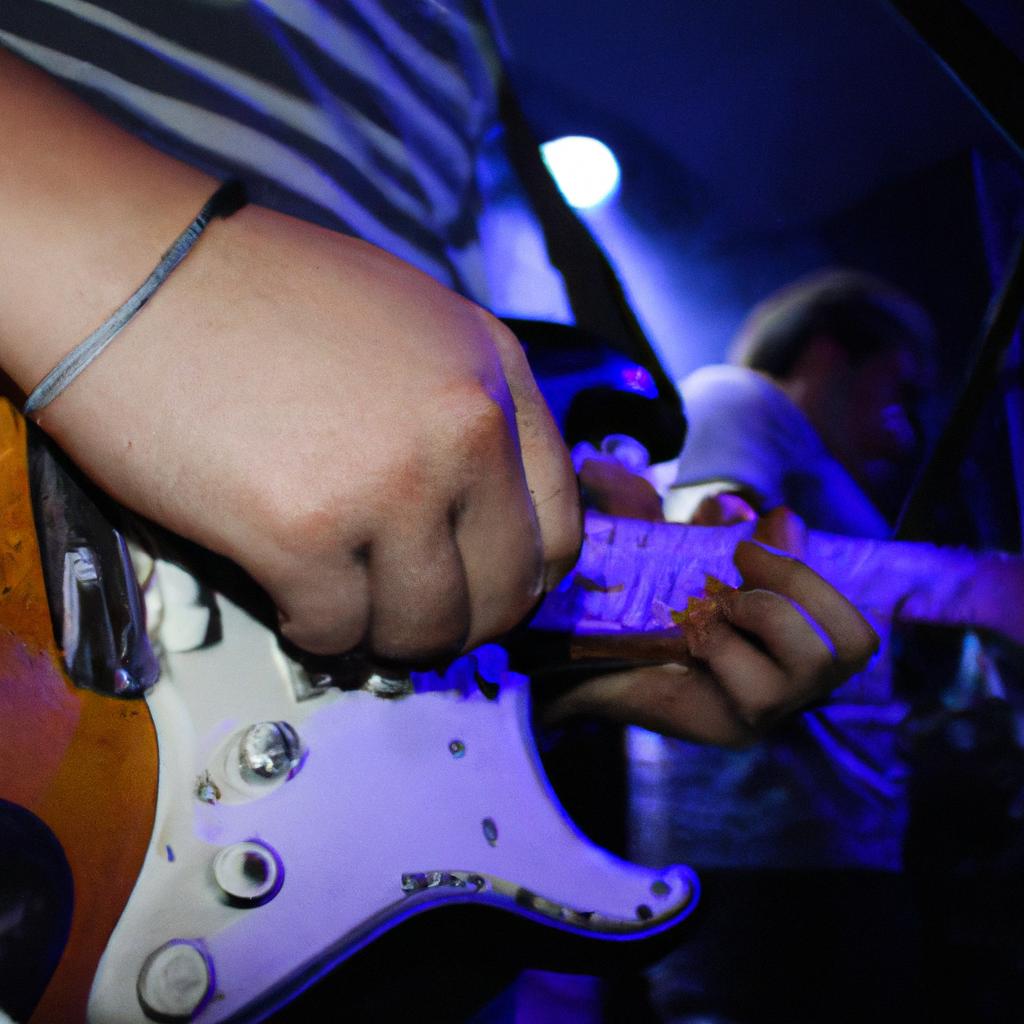Coldwave is a subgenre of Gothic music that emerged in the late 1970s and gained popularity during the 1980s. This dark and atmospheric genre draws inspiration from elements of post-punk, new wave, and synth-pop, resulting in a unique sound characterized by haunting melodies, introspective lyrics, and an overall sense of melancholy. One example of this captivating genre can be found in the music of The Cure, a British band widely regarded as one of the pioneers of Coldwave. With their gloomy yet mesmerizing compositions such as “A Forest” and “Pictures of You,” The Cure exemplifies the essence of Coldwave’s emotional depth.
The origins of Coldwave can be traced back to the cultural climate of its time, where artists sought to express their disillusionment with mainstream society through unconventional musical styles. As part of the larger Gothic movement in music and fashion, Coldwave embraced themes associated with darkness, introspection, and existential angst. Bands like Joy Division and Bauhaus played pivotal roles in shaping this emerging subgenre by combining post-punk’s raw energy with eerie synthesizers and ethereal vocals. In doing so, they created an evocative sonic landscape that resonated deeply with audiences seeking alternative forms of artistic expression.
Coldwave stands out for its introspective and poetic lyrics, often addressing themes of isolation, loss, and the complexities of human emotions. The genre’s atmospheric soundscapes, characterized by reverb-drenched guitars, haunting synthesizers, and brooding basslines, create a sense of melancholic beauty that captivates listeners. This combination of emotional depth and sonic experimentation distinguishes Coldwave from other genres in the Gothic music umbrella.
The influence of Coldwave can still be felt today in various forms of alternative music. Many contemporary artists continue to draw inspiration from the genre’s moody aesthetics and introspective themes. Bands like She Past Away, Lebanon Hanover, and Drab Majesty have gained popularity in recent years by channeling the spirit of Coldwave into their own unique musical visions.
In summary, Coldwave is a subgenre of Gothic music that emerged in the late 1970s and gained prominence during the 1980s. It combines elements of post-punk, new wave, and synth-pop to create a dark and atmospheric sound characterized by haunting melodies and introspective lyrics. The Cure is an example of a band that exemplifies the essence of Coldwave with their gloomy yet mesmerizing compositions.
Origins of Coldwave
Coldwave, a subgenre of Gothic music that emerged in the late 1970s and early 1980s, has its origins rooted in the post-punk movement. This darker and more atmospheric offshoot gained popularity primarily in Europe, particularly France and Belgium. To illustrate this point, let us consider the case study of French band “Norma Loy,” whose music embodied the essence of Coldwave.
The emergence of Coldwave can be attributed to several factors. Firstly, it was a response to the commercialization and mainstream success of punk rock. Many artists sought to explore a different musical direction by incorporating elements of electronic music with an emphasis on melancholic atmospheres and introspective lyrics. Secondly, there was a growing fascination with existentialism and nihilism during this time period, which influenced the lyrical themes explored within Coldwave music.
To understand the emotional impact of Coldwave, one must delve into its characteristics:
- Dark Atmosphere: Coldwave is characterized by its brooding and somber soundscapes that create an atmosphere reminiscent of desolation and despair.
- Minimalist Approach: Artists embraced minimalism as they stripped down their compositions to essential elements, often utilizing repetitive rhythms and sparse instrumentation.
- Introspective Lyrics: The lyrics in Coldwave songs tend to be introspective, exploring themes such as isolation, alienation, loss, and existential angst.
- Experimental Sound: There was a strong experimental element present in many Coldwave tracks. Musicians incorporated unconventional instruments or utilized innovative production techniques to achieve unique sonic textures.
In conclusion, Coldwave originated as an alternative expression within the broader Gothic music scene. Its roots lie in post-punk’s desire for artistic exploration beyond conventional boundaries while embracing darker aesthetics. In the subsequent section about “Characteristics of Coldwave,” we will further examine how these initial foundations evolved into distinct musical traits that define this captivating subgenre.
Characteristics of Coldwave
From its origins in the late 1970s, Coldwave emerged as a distinct subgenre within the realm of Gothic music. Building upon the foundations laid by post-punk and new wave, Coldwave encapsulates a unique blend of dark atmospheres, melancholic melodies, and introspective lyrics. This section will delve into the characteristics that define Coldwave, exploring how it distinguishes itself from other genres within the Gothic spectrum.
One notable characteristic of Coldwave is its emphasis on minimalism and experimentation. Artists often employ sparse instrumentation, relying heavily on synthesizers, drum machines, and distorted guitars to create an eerie sonic landscape. For instance, imagine a hypothetical band called “Frozen Echoes” using haunting synth textures layered over pulsating electronic beats to evoke feelings of desolation and detachment. This minimalist approach allows for a sense of icy coldness permeating throughout the music.
Furthermore, the lyrical themes prevalent in Coldwave contribute to its distinctive identity. Despair, isolation, existential ponderings — these are recurring motifs found within the genre’s songs. The haunting lyrics paint vivid pictures of emotional turmoil and psychological struggles faced by individuals grappling with their inner demons. To illustrate this point further:
-
Bullet Point List:
- Loneliness
- Nihilistic tendencies
- Alienation from society
- Reflections on mortality
To better understand the essence of Coldwave’s thematic scope, let us consider a table showcasing some song titles along with their associated topics:
| Song Title | Associated Topic |
|---|---|
| “Frostbitten Soul” | Inner emptiness |
| “Shadows in Solitude” | Isolation |
| “Eternal Winter” | Existential dread |
| “The Abyss Within” | Descent into darkness |
In conclusion,
Transitioning into our next topic about Influences on Coldwave, it is worth noting that the characteristics of Coldwave are not isolated phenomena. They have been shaped by a myriad of external factors, ranging from other musical genres to cultural movements and technological advancements. By exploring these influences, we can gain a deeper understanding of how Coldwave has evolved over time.
[Influences on Coldwave]
Influences on Coldwave
Building upon the brooding soundscape of post-punk and incorporating elements from electronic music, Coldwave emerged as a distinct subgenre within the gothic music scene. Its unique blend of gloomy atmospheres, haunting melodies, and introspective lyrics has captivated listeners with its dark allure. To better understand the characteristics of Coldwave, let us explore its defining features through an example.
Imagine a song by renowned Coldwave artist X: ‘Shadowed Desolation.’ From the very first notes, one is transported into a world shrouded in melancholy. The slow-paced rhythm sets an eerie tone, while ethereal synths create a chilling backdrop. As the vocalist’s deep voice resonates with raw emotion, lyrical themes of isolation and despair unfold. This haunting composition exemplifies some key characteristics that define Coldwave:
- Minimalistic instrumentation: Focusing on simplicity rather than complexity, Coldwave often employs sparse arrangements to accentuate its bleak atmosphere.
- Dark and introspective lyrics: Exploring themes such as loss, existential angst, and emotional turmoil intensifies the emotive impact of Coldwave songs.
- Atmospheric soundscapes: Utilizing atmospheric effects like reverb and delay creates an immersive sonic experience reminiscent of desolate landscapes or decaying urban environments.
- Electronic influence: Incorporating synthesizers and drum machines adds a cold mechanical edge to the genre’s overall aesthetic.
To further illustrate these characteristics visually:
| Characteristics | Example |
|---|---|
| Minimalistic instrumentation | Sparse guitar strumming accompanied by pulsating bass lines |
| Dark and introspective lyrics | Lyrical exploration of personal struggles and societal disillusionment |
| Atmospheric soundscapes | Echoing vocals reverberate amidst layers of haunting synth textures |
| Electronic influence | Drum machine beats merge seamlessly with traditional instruments |
These traits collectively form the foundation upon which Coldwave builds its distinctive sound. By skillfully combining elements from various genres, Coldwave creates a captivating sonic landscape that resonates with listeners seeking introspection and catharsis.
Transitioning seamlessly into the subsequent section about “Prominent Coldwave Bands,” we delve deeper into the artists who have shaped and contributed to this hauntingly beautiful subgenre.
Prominent Coldwave Bands
Transitioning from the influences that shaped coldwave, we now delve into the prominent bands within this subgenre. One such example is the French band Trisomie 21. Formed in the early 1980s by brothers Philippe and Hervé Lomprez, their music embodies the essence of coldwave with its melancholic melodies and introspective lyrics.
To fully appreciate the significance of these bands, it is important to understand some key elements that define coldwave. First, there is a stark contrast between dark atmospheric sounds and ethereal synth-driven compositions. This fusion creates an enigmatic atmosphere that draws listeners into a world of emotional intensity. Second, many coldwave artists explore themes of isolation, existentialism, and societal disillusionment through their lyrics. This introspective approach adds depth to their music and resonates with fans who find solace in its brooding tones.
To further illustrate the impact of coldwave, here is a bullet point list highlighting its emotional appeal:
- Evokes feelings of nostalgia and longing
- Captures a sense of despair while offering catharsis
- Provides an outlet for personal expression during difficult times
- Fosters a community where individuals can connect through shared experiences
Additionally, let us examine a table showcasing notable coldwave bands along with their defining characteristics:
| Band | Origin | Defining Characteristics |
|---|---|---|
| Trisomie 21 | France | Melancholic melodies intertwined with electronic soundscapes |
| Clan of Xymox | Netherlands | Moody vocals layered over haunting guitar riffs |
| Cocteau Twins | Scotland | Ethereal harmonies accompanied by dreamlike instrumentation |
| The Cure | England | Dark lyrics complemented by a mix of post-punk and new wave |
In conclusion, the prominent bands within the coldwave subgenre have shaped its distinctive sound and themes. Their music captivates audiences through its unique blend of atmospheric sounds, introspective lyrics, and emotional depth. Transitioning into the subsequent section about “Coldwave Subgenres,” we explore how this subgenre has evolved over time to encompass various musical influences while retaining its dark allure.
Coldwave Subgenres
Section: Coldwave Subgenres
Following our exploration of prominent Coldwave bands, let us now delve into the various subgenres that have emerged within this dark and captivating genre. To illustrate the diversity, we will focus on one particular subgenre as an example – Ethereal Wave.
Example Case Study: Ethereal Wave
Ethereal Wave is a mesmerizing subgenre of Coldwave that emerged in the 1980s. It combines elements of dream pop and post-punk to create an ethereal and otherworldly sound. Bands such as Cocteau Twins and Dead Can Dance are notable pioneers of this subgenre, enchanting listeners with their atmospheric compositions characterized by haunting vocals, shimmering guitars, and ethereal synthesizers.
Within the realm of Coldwave, several distinct subgenres have evolved over time, each offering a unique musical experience. Here are some commonly recognized subgenres:
- Minimal Wave: This minimalist form of Coldwave emphasizes sparse instrumentation, repetitive rhythms, and cold electronic textures. Artists like Martial Canterel and Xeno & Oaklander exemplify this style with their stripped-down yet evocative compositions.
- Dark Ambient: In contrast to more melodic forms of Coldwave, Dark Ambient delves deep into atmospheric soundscapes. Utilizing drones, field recordings, and eerie synth pads, artists like Lustmord and Kammarheit create immersive sonic environments that evoke feelings of desolation and introspection.
- Industrial: Blending elements from industrial music with Coldwave sensibilities results in a harsh and abrasive sonic landscape. Industrial-influenced Coldwave bands like Front Line Assembly and Skinny Puppy employ aggressive beats, distorted vocals, and heavy use of electronics to convey themes of societal decay and dystopia.
- Neoclassical: Combining classical influences with the brooding aesthetics of Coldwave gives rise to Neoclassical subgenre. Artists such as Arcana and Sophia utilize orchestral arrangements, piano melodies, and operatic vocals to create a darkly romantic atmosphere that is both haunting and beautiful.
To further illustrate the diversity within Coldwave subgenres, here is a table showcasing some key characteristics of each:
| Subgenre | Key Characteristics |
|---|---|
| Minimal Wave | Sparse instrumentation, repetitive rhythms |
| Dark Ambient | Atmospheric soundscapes, drones |
| Industrial | Aggressive beats, distorted vocals |
| Neoclassical | Orchestral arrangements, piano melodies |
As we can see from this exploration of Coldwave subgenres, the genre offers an array of musical styles that cater to different emotional responses. While Ethereal Wave enchants with its dreamy allure, Minimal Wave captivates through its minimalist beauty. Dark Ambient immerses listeners in atmospheric depths while Industrial confronts them with aggressive intensity. Finally, Neoclassical creates a sense of elegance amidst the darkness.
Transitioning into our next section on the Impact and Legacy of Coldwave…
Impact and Legacy of Coldwave
Transition from the previous section:
Building upon the exploration of Coldwave subgenres, this section delves into the impact and legacy that Coldwave has left on the Gothic music scene. By examining its influence on subsequent genres and artists, we can gain a deeper understanding of how Coldwave shaped the darkwave movement.
Section Title: Impact and Legacy of Coldwave
Coldwave’s unique blend of atmospheric sounds, gloomy lyrics, and industrial undertones has had a profound impact on various aspects of Gothic music. One example showcasing Coldwave’s lasting influence is the rise of French band Trisomie 21 in the early 1980s. With their haunting melodies and introspective themes, Trisomie 21 became synonymous with the essence of Coldwave and contributed significantly to its popularity within the genre.
To comprehend the broader impact of Coldwave, it is essential to acknowledge its role in shaping subsequent musical movements. The following list highlights some key developments influenced by Coldwave:
- Increased experimentation with electronic instruments
- Fusion of post-punk elements with darker atmospheres
- Exploration of nihilistic themes and existential musings
- Emphasis on minimalism and unconventional song structures
This table presents an overview of notable artists who have drawn inspiration from Coldwave:
| Artist | Genre | Notable Works |
|---|---|---|
| She Past Away | Post-Punk/Darkwave | “Belirdi Gece,” “Narin Yalnızlık” |
| Lebanon Hanover | Dark Synthpop | “Tomb For Two,” “Gallowdance” |
| Drab Majesty | New Wave/Post-Punk | “The Demonstration,” “Modern Mirror” |
| Soft Kill | Shoegaze/Post-Punk | “An Open Door,” “Heresy” |
In addition to influencing subsequent music, Coldwave’s legacy can be seen in the continued popularity and resurgence of darkwave as a subgenre. Its brooding and melancholic tones have resonated with audiences seeking an introspective musical experience. The enduring appeal of bands like Trisomie 21 and their impact on contemporary artists is a testament to Coldwave’s lasting influence.
Through its exploration of atmospheric soundscapes, nihilistic themes, and unique sonic textures, Coldwave has left an indelible mark on Gothic music. As evidenced by the rise of Trisomie 21 and the ongoing inspiration it provides for emerging artists, Coldwave’s legacy continues to thrive within the broader darkwave genre. By pushing boundaries and embracing darkness, Coldwave remains an influential force that shapes the artistic landscape even today.




